The May Day protests in France, organised by the main trade unions and supported by all the “left” parties, witnessed a turnout of between 500,000 and a million workers and youth demonstrating against mass unemployment and government austerity policies.
This large-scale participation, however, was well below the unions’ aim of surpassing the March 19 mobilisation of some 1-3 million, and reflected a growing disillusionment with the unions’ perspective of calling on the government to act in favour of the working class. The government has repeatedly made it clear that it intends to continue its austerity policies in collaboration with the unions and the employers, an urgent imperative for French capitalism in the deepening recession.
Raymond Soubie, President Nicolas Sarkozy’s social counsellor, announced on Saturday a meeting with the unions and the employer before the end of June to “assess” measures required for the crisis. He told radio Europe 1: “What the president wants is to have permanent contacts with the union and employers’ organisations so as to always have a suitable and concrete response.”
WSWS correspondents reported from the demonstrations in Paris, Marseille, Nancy in eastern France, and Amiens in Picardy, in the north. WSWS teams gave out thousands of copies of the article “France: Caterpillar workers in revolt against the unions”
Paris
According to the CGT, 160,000 people participated in the Paris demonstration, under half the number on the March 19 protest. The biggest trade union contingents were the CGT (General Confederation of Labour, close to the Communist Party), followed by the education union, the FSU (Federation Syndicate Unitaire). The union contingents were more dominant than they had been in March. There were many hospital workers and students, protesting cuts in the health and education services.
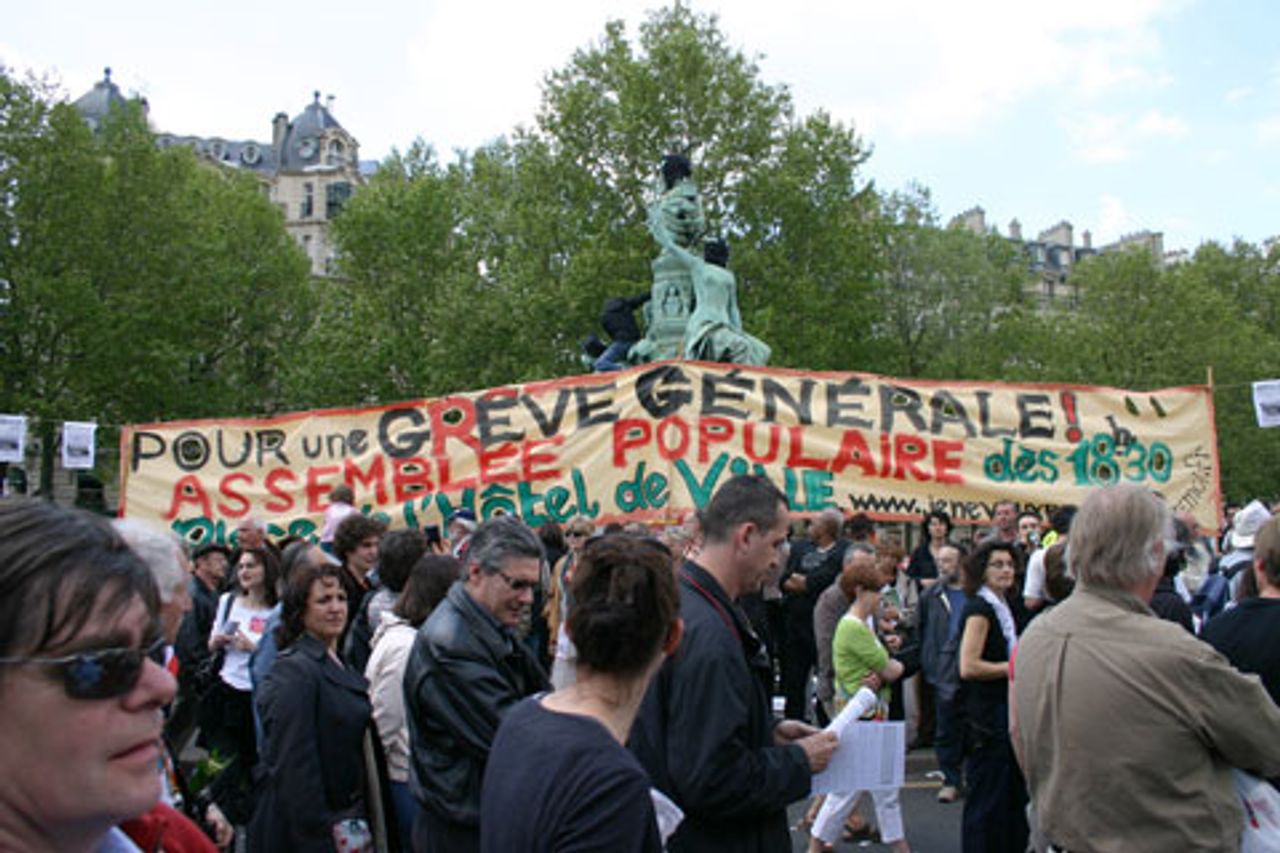 Demonstrators in Paris
Demonstrators in ParisOne demonstrator told the WSWS: “Today’s situation pushes us to read seriously, to understand the world crisis.” Many agreed with the WSWS criticism of the collusion between the unions, the bosses and the government at Caterpillar to impose job cuts and increased exploitation of workers.
There were many immigrant workers and youth: Turks, Kurds, sans papiers (undocumented workers) from Asia and Africa. Tamils with their families protested against the atrocities being committed in the civil war in Sri Lanka, and also against the social crisis in France. Nationalists under the influence of the Tamil Tigers of the LTTE brandished portraits of Sarkozy and Obama, to whom they are appealing for support.
There was a pact in Paris with the national unions that the left parties would not march with the demonstration, but show support from the pavement sidelines.
The New Anti-capitalist Party along with the Socialist Party (PS) and other “left” parties had signed a joint statement of support for the unions’ May Day mobilisation. This enabled the PS to participate for the first time since PS Prime Minister Lionel Jospin was beaten into third place in the 2002 presidential elections by the neo-fascist Jean-Marie Le Pen. Jospin’s Plural Left government’s pro-capitalist policies had made him unelectable.
Only the recognition of the Socialist Party as part of the left by the NPA and its predecessor, the Ligue Communiste Révolutionnaire, permitted it to gather a crowd of 3,000 to line the street as the demonstration passed. Martine Aubry, PS first secretary, jubilantly told the press: “The socialists are there, in their place, behind the unions, happy to rediscover their values.”
The other “left” parties—the NPA, Lutte Ouvrière, the Left Party, the Communist Party—had their spot at the side of the street, from which they expressed their unity with the union bureaucracy:
A teacher told the WSWS, “I would like the capitalist system to be opposed. We must organise internationally.” Jean-Rodolphe, an information technology teacher in the Paris region, said that fewer and fewer teachers were being trained in his field—posts are not being made available. “Total [oil company] is making millions and giving it to the shareholders when there are unemployed people,” he said. “It annoys me.”
Marseille
The CGT said 35,000 participated in the Marseille protest; police estimated 8,500. The decline from the 250,000 claimed by the trade unions on March 19 was in part due to the fact that this demonstration did not draw people in from the surrounding towns, which had their own marches. There were few high school or university students present.
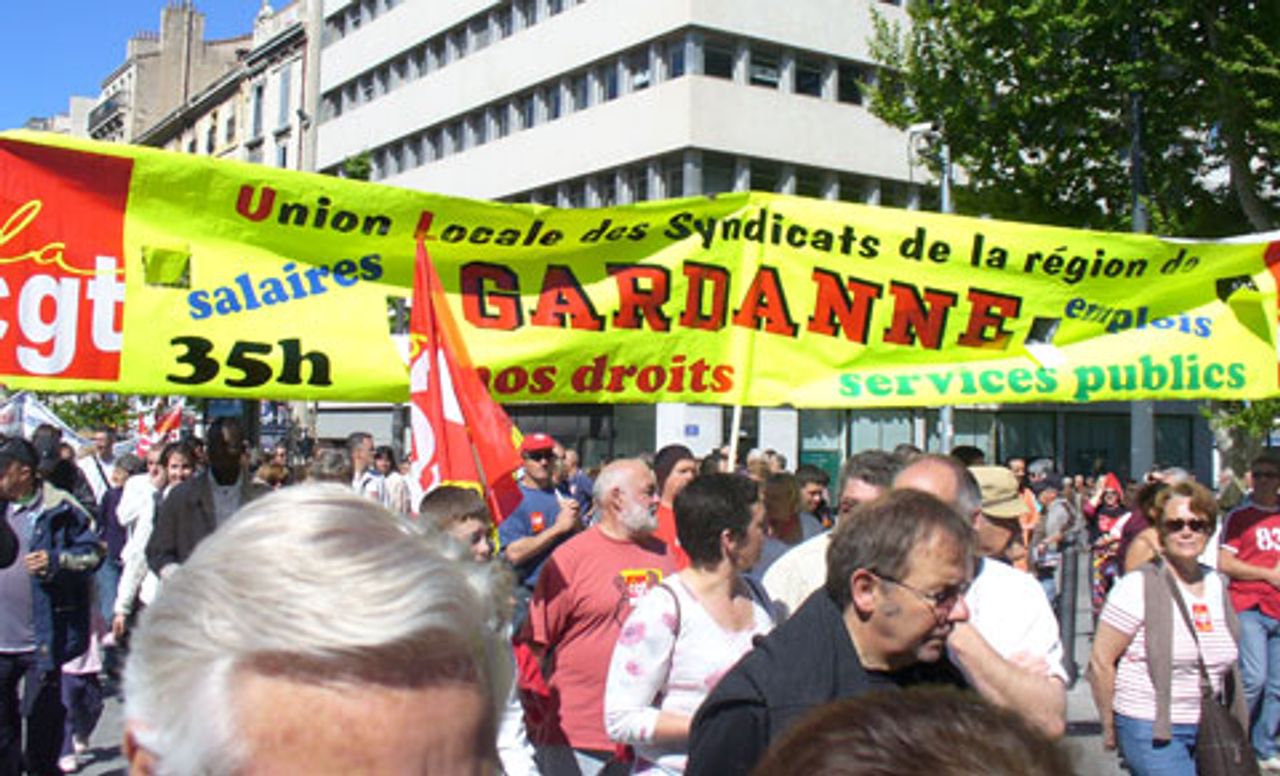 Gardanne public service union
Gardanne public service unionThe protest was very much under the control of the eight union confederations, dominated by the CGT, with few people independent of them. The lack of support beyond their ranks testifies to a growing disillusion in these organisations of class collaboration.
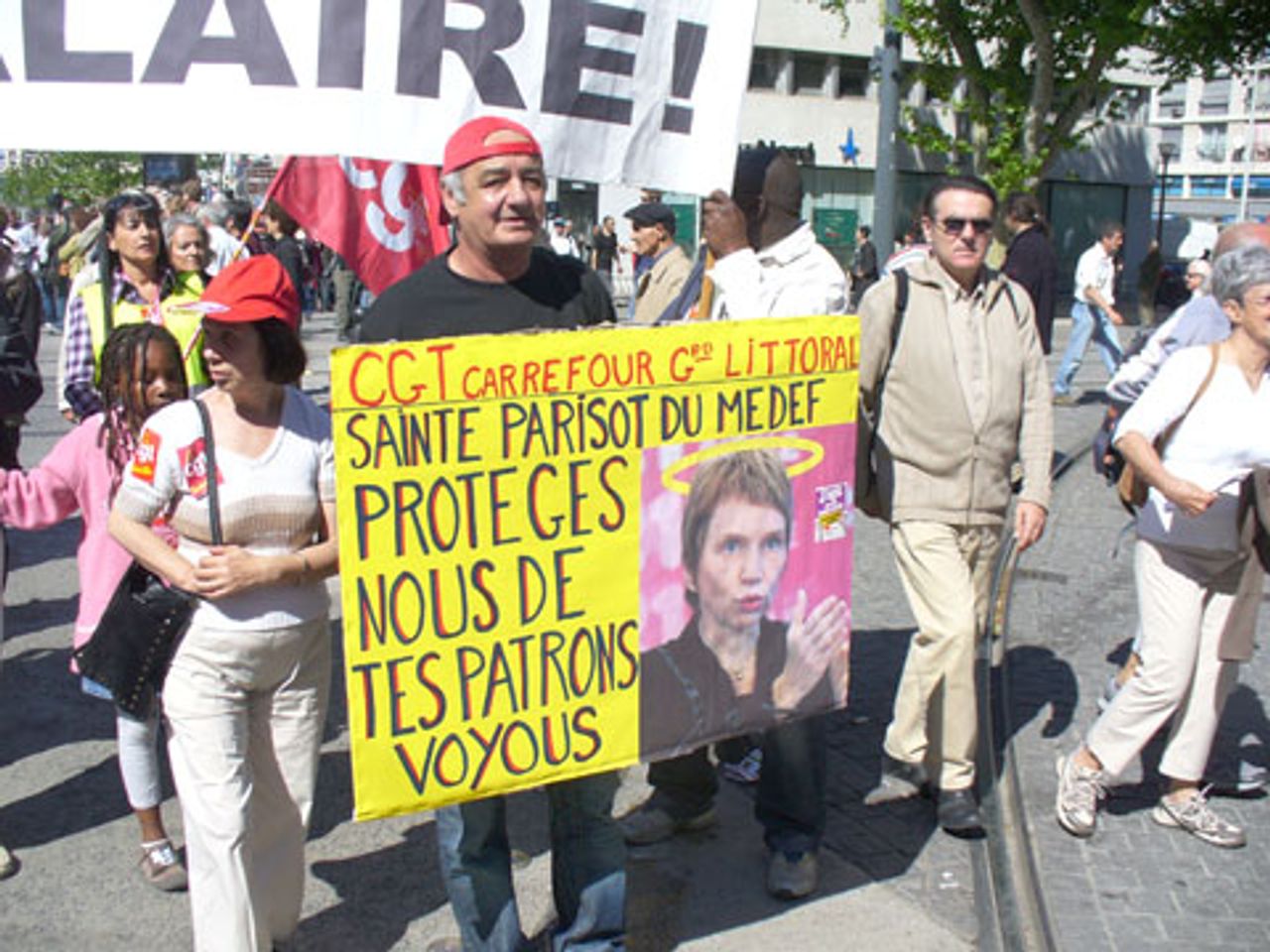 Carrefour shop workers: "Saint Parisot of Medef (bosses association president) protect us from gangster bosses"
Carrefour shop workers: "Saint Parisot of Medef (bosses association president) protect us from gangster bosses"Delegations from the Communist Party, Lutte Ouvrière (LO), the Left Party and the Greens were part of the procession. The POI (Independent Workers Party, formerly the PT of Pierre Lambert), and the anarchist Libertarian Alternative handed out leaflets.
The WSWS leaflet referring to the revolt of the Caterpillar workers against the trade unions attracted the interest of many trade union members. They read and kept it, contrary to the leaflets handed out by the NPA and LO and the trade unions.
Renée, a former CGT member, said: “The ‘boss-nappings’ are legitimate; the workers have nothing to lose.” Only hearing of the Caterpillar revolt from the WSWS team, she commented, “It’s not the answer to fight back against the unions even if they are not necessarily up to the job.”
Thierry, 43, a teacher, said, “I’m pessimistic for the youth—there’s no hope with the crisis. There will be many young people out of work and without rights. Workers should be defended by the unions and the political parties.” He angrily rejected the idea that the unions were complicit with the bosses: “It’s ridiculous. The unions historically have defended workers in the workplace.” He said he was for tripartite negotiations and that “the unions were not created for revolution.”
Nancy
The Nancy demonstration attracted 20,000 marchers, according to the unions, who organized around the slogans: “For jobs and purchasing power,” “To prepare a better world for our children,” “For a mass movement, because the government treats us like idiots.”
 Banner in Nancy: "No to the privitisation of the post office--For quality public service"
Banner in Nancy: "No to the privitisation of the post office--For quality public service"A widely chanted slogan, put forward by the FO union (Workers Power), denying the gravity of the crisis, was: “There’s money—in the bosses’ treasuries!”
Teachers demanded a halt to the “break-up of public education” and called for “respect for free, public, secular, compulsory education and for trade union rights.”
Amiens
Three thousand marched through Amiens, the capital of Picardy, down from 12,000 on March 19 and less than the 6,000 in the smaller Picardy town of Compiègne, where tyre workers are fighting to stop the closure of the Continental tire factory at Clairoix, threatening the loss of 1,200 jobs.
The lead banner in Amiens, representing the eight trade unions, called for “Real jobs, rights and purchasing power.” Public sector workers made up the main body of marchers, which was dominated by the CGT and the FSU education union. Also present were electricity and gas workers, tax department workers, hospital staff, university and high school students.
Although strikes and protests against government autonomy plans have disrupted Amiens’ 20,000-strong university campus for over three months, the student and teacher presence was just a few hundred.
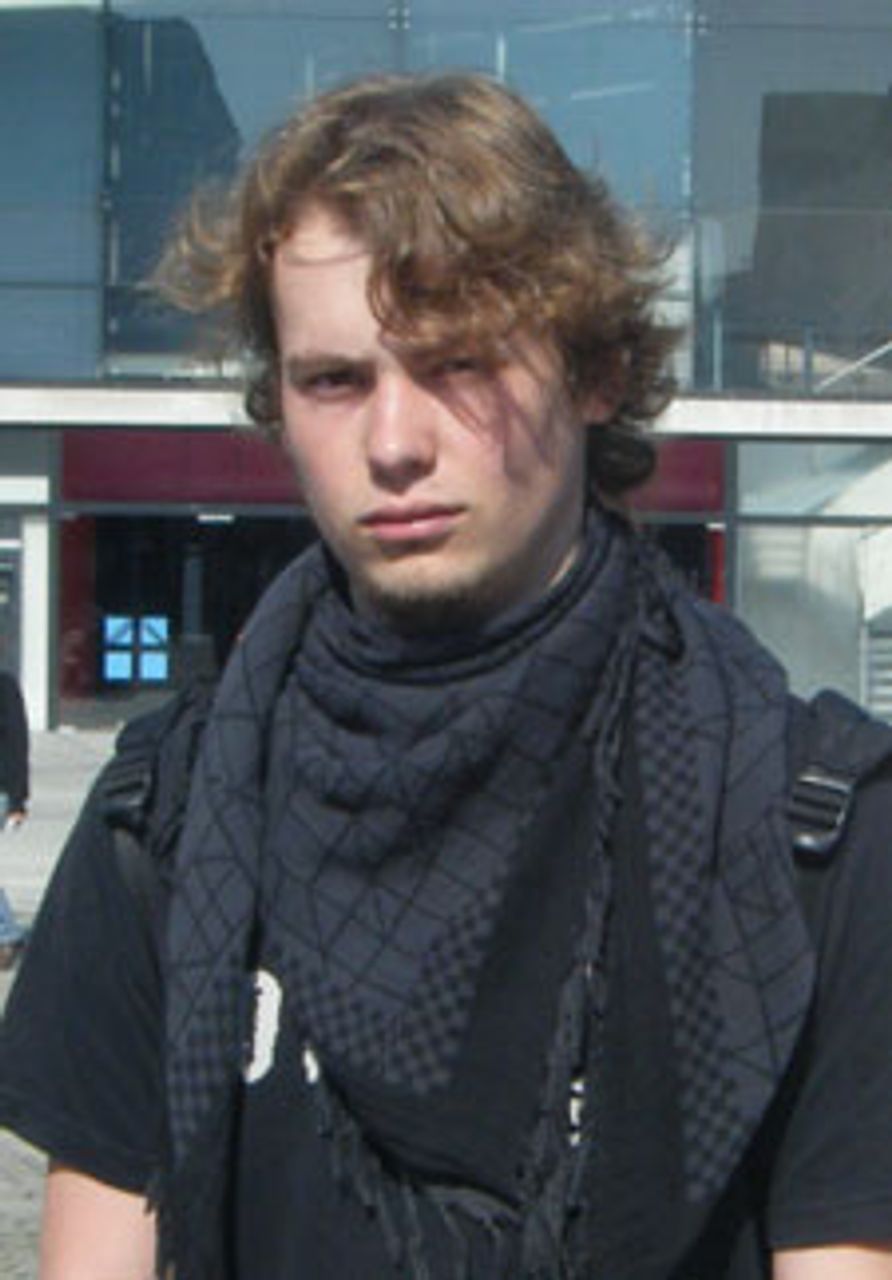 Arnaud
ArnaudArnaud, a second-year student specialising in literature at the Michelis High School in Amiens, said, “I’ve been active against the high school reform and I’m a member of the school action committee. We put our demands to the regional education chief (recteur). We came to realise that the state doesn’t give a damn.”
He added: “I think we need a new party to be set up which is truly independent and based on the understanding of history, for example the lessons of the 1936 and 1968 struggles. We don’t want trade unions like the PS and the Communist Party. We need an international party that struggles for economic and social equality.”
Arnaud continued, “The banks and businesses must become public services and be run by an egalitarian government. Your perspective of building an international party seems very good from the point of view of form, but I would have to see the content to say if I’m completely in agreement. I would like to have more discussion to know more.”
Hervé Lemaire, a CGT official at electricity and gas utility EDF-GDF, told the WSWS, “We’ve been organising rolling strikes and pickets for four weeks. We are asking for a rise of 5 percent in basic pay and a fair share of the 10 billion euro profit.” The company is semi-privatised. EDF electricity is 51 percent state-owned but is run as a capitalist enterprise. Workers are also fighting the contracting out of work. Accepting the logic of the capitalist market, he said that this “is going to weaken the company in the European context. We risk losing our leading role as an energy supplier in Europe.”
Reflecting the outlook of the union leaders, he said that the recent series of wildcat electricity cut-offs to political figures and government buildings “are not supported by the unions, but we are having difficulty controlling the conflicts.”
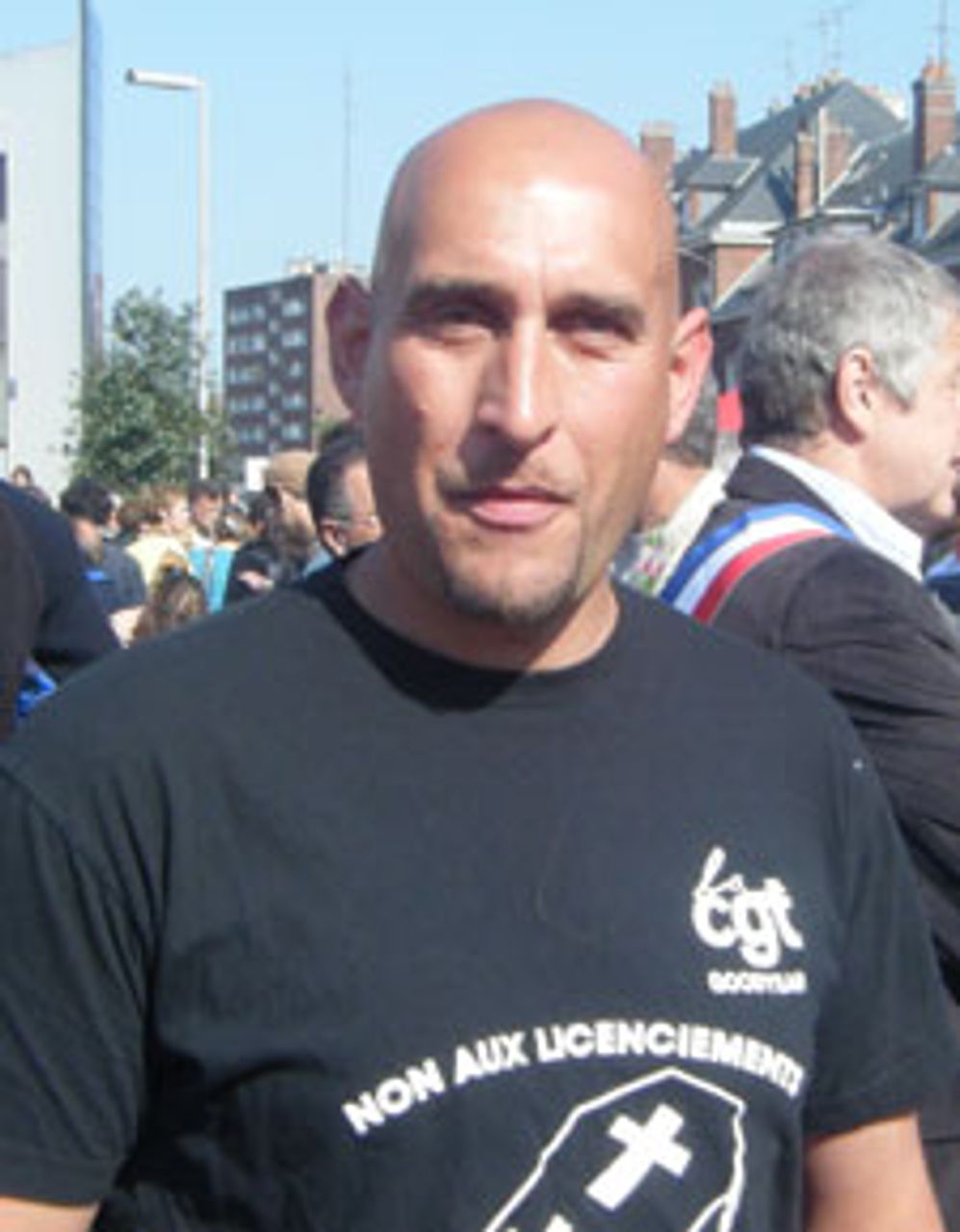 Reynald Turpin
Reynald TurpinReynald Turpin, sporting a black T-shirt identifying him as him as a worker at the Dunlop-Firestone enterprise in Amiens, was marching with his wife and children. Extremely angry at the refusal of the CGT to lead a fight against seven-day working at the Dunlop plant, he said: “We don’t have weekends. It creates big problems for family life.
Upon learning of the role of the unions at Caterpillar, he exclaimed: “It fills me with hatred.” He told the WSWS that Goodyear was setting up a factory in Poland with new machines capable of producing 40,000 tyres a day. “In Amiens we produce 15,000 per day,” he said.
“It will take a common fight throughout the world to defend jobs. I agree with the colleagues at Continental in Germany when they met the Clairvoix workers with a placard with the words ‘Workers of the world, unite.’ I agree about the need to build independent organisations of struggle, but we mustn’t tar all the unions with the same brush. The working class has to be united throughout the world to reorganise the world economy. It is to be seen if it is possible to build an international party as your international intends ... that will be a big undertaking.”
